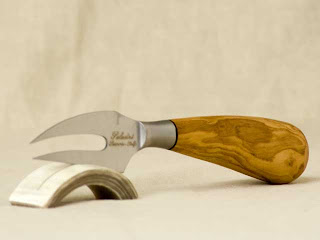Cheese is one of the
products we love, because is the perfect partner for the Spanish Ham (but red wine as well). As you know, there are so many varieties and sometimes is
difficult to know how cut and serve each one properly.
First of all, a bit of
History about cheese:
Cheese is one of the
oldest foods of mankind. The ancient Greeks believed it had healing properties.
Attila ate cheese made from mare’s milk. And the Romans, great cheese
manufacturers, extended its consume and tradition around the Empire.
Throughout History, man
had devises several ways to make cheese, different tastes and textures.
Nowadays, many cheeses are made using traditional methods, but the process has
been improved thanks to technical developments.
Cheese is only the remaining
solid matter when you remove milk serum, by pressure or cooking. All cheeses
are made from milk, whether cow, goat, sheep (really good in Spain
Well, and how to cut
cheese?
Cheeses have different
shapes and sizes, and it’s not easy to know how to cut each type. To avoid
unnecessary waste and make each piece more appetizing, it’s interesting to use
a proper technique for each one.
- Soft
cheeses (round or square), and the moldy, have to be cut into small pieces.
- Cylindrical
cheeses are cut in two parts.
- Those
roll or bar-shaped have to be cut into individual slices (thicker or thinner,
depending on the guests).
- If
it’s a ball, first split in half, then cut a hexagonal piece, and from this you
can make slices.
Ok! It seems easy. But,
what about tools for cut cheese?
All cheeses can be cut
with a knife (obviously), but according to their consistency and texture is
more appropriate to use a special cutting tool.
- The
extra hard cheeses can’t be cut into sliced, it’s better to break them. Is
necessary a small short knife. The tip should be applied to the cheese and as a
lever to cut it down.
- For
cutting large cheeses is used a strand wire. First crust is marked for strand
wire slides easily.
- Moldy
semi-rigid, which normally are brittle, are also cut with a strand wire. Tip: cut
it right out of the fridge (the hotter, the softer).
- To
slice moldy rigid, cream or roll cheese, use the bow. In this case, the strand
wire is fixed in a carrier.
- Hard
cheeses can be cut with a palette knife. But they are small normally, so if is
a large cheese, use a big knife with a wide blade.
- There
are special knifes with two tips, for small pieces and soft cheeses. With this
tool you can serve directly to the plate. Tip: normally dull knives cut better
than the sharp. If heated slightly (eg by soaking in hot water) the blade will
slide by the cheese as it was butter.
- The
‘girolle’ is a tool with a wood round base and a blade attached to a shaft at
its top, which allows to make rosette-shape pieces.
- Graters
are useful for skim hard and extra hard cheeses. For rigid is better to use
small holes graters, to make thin strips. For semi-rigid is more appropriate to
use large holes graters, resulting larger cheese strips. To grate cheese,
electric grinders can also be used.




















No hay comentarios:
Publicar un comentario